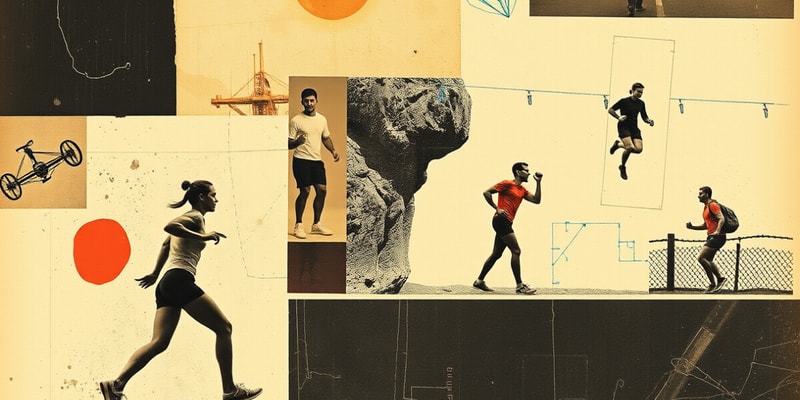Podcast
Questions and Answers
What distinguishes a training program from general exercise?
What distinguishes a training program from general exercise?
Which principle of training emphasizes the need to improve gradually to ensure progress?
Which principle of training emphasizes the need to improve gradually to ensure progress?
What does the principle of 'individuality' imply in training programs?
What does the principle of 'individuality' imply in training programs?
What factor is crucial for adaptation to occur in the human body during training?
What factor is crucial for adaptation to occur in the human body during training?
Signup and view all the answers
Which muscle action is classified under lower body multi-joint movements?
Which muscle action is classified under lower body multi-joint movements?
Signup and view all the answers
What is a common outcome of failing to progressively overload during training?
What is a common outcome of failing to progressively overload during training?
Signup and view all the answers
Which of the following is NOT one of the fundamental movements in performance training?
Which of the following is NOT one of the fundamental movements in performance training?
Signup and view all the answers
What does DOMS stand for in the context of exercise and training?
What does DOMS stand for in the context of exercise and training?
Signup and view all the answers
Which principle would likely lead to decreased physical performance if not adhered to?
Which principle would likely lead to decreased physical performance if not adhered to?
Signup and view all the answers
Which of the following actions represents a single joint movement in the upper body?
Which of the following actions represents a single joint movement in the upper body?
Signup and view all the answers
What is the primary focus when establishing a needs analysis for an athlete?
What is the primary focus when establishing a needs analysis for an athlete?
Signup and view all the answers
Which of the following is NOT considered in the assessment of an athlete?
Which of the following is NOT considered in the assessment of an athlete?
Signup and view all the answers
What does KPI stand for in the context of evaluating a sport?
What does KPI stand for in the context of evaluating a sport?
Signup and view all the answers
Which type of analysis is included in the evaluation of a sport according to the established plan?
Which type of analysis is included in the evaluation of a sport according to the established plan?
Signup and view all the answers
In the context of lifting techniques, what type of rotation is generally observed?
In the context of lifting techniques, what type of rotation is generally observed?
Signup and view all the answers
What should be included in the timeline when establishing a training plan?
What should be included in the timeline when establishing a training plan?
Signup and view all the answers
Which stance or position is most relevant for certain types of movement?
Which stance or position is most relevant for certain types of movement?
Signup and view all the answers
Which of the following best defines anti-extension exercises?
Which of the following best defines anti-extension exercises?
Signup and view all the answers
What aspect does a physiological analysis examine?
What aspect does a physiological analysis examine?
Signup and view all the answers
Which plane of motion does vertical flexion primarily occur in?
Which plane of motion does vertical flexion primarily occur in?
Signup and view all the answers
Match the following principles of training with their descriptions:
Match the following principles of training with their descriptions:
Signup and view all the answers
Match the following muscle action types with their corresponding movements:
Match the following muscle action types with their corresponding movements:
Signup and view all the answers
Match the fundamental movements with their corresponding actions:
Match the fundamental movements with their corresponding actions:
Signup and view all the answers
Match the training load application strategies to their descriptions:
Match the training load application strategies to their descriptions:
Signup and view all the answers
Match the following fitness assessment categories with their appropriate focus:
Match the following fitness assessment categories with their appropriate focus:
Signup and view all the answers
Match the following training program types with their features:
Match the following training program types with their features:
Signup and view all the answers
Match the following upper body actions with their classifications:
Match the following upper body actions with their classifications:
Signup and view all the answers
Match the following levels of training with their corresponding concepts:
Match the following levels of training with their corresponding concepts:
Signup and view all the answers
Match the following types of training stimuli with the desired adaptations:
Match the following types of training stimuli with the desired adaptations:
Signup and view all the answers
Match the types of motion with their corresponding descriptions:
Match the types of motion with their corresponding descriptions:
Signup and view all the answers
Match the terms related to positions with their descriptions:
Match the terms related to positions with their descriptions:
Signup and view all the answers
Match the types of resistance training with their corresponding focuses:
Match the types of resistance training with their corresponding focuses:
Signup and view all the answers
Match the assessment components with their focus areas:
Match the assessment components with their focus areas:
Signup and view all the answers
Match the analysis methods with their respective focuses:
Match the analysis methods with their respective focuses:
Signup and view all the answers
Match the training concepts with their definitions:
Match the training concepts with their definitions:
Signup and view all the answers
Match the movement types with examples:
Match the movement types with examples:
Signup and view all the answers
Match the terms related to resistance training with their characteristics:
Match the terms related to resistance training with their characteristics:
Signup and view all the answers
Match the training principles to their implications:
Match the training principles to their implications:
Signup and view all the answers
Study Notes
Exercise vs. Training
- Exercise is any physical activity and does not require a specific plan.
- Training involves a comprehensive and progressive plan, with a specific purpose.
Principles of Training
- Progressive Overload: Constantly increasing the stimulus – usually by increasing weight – to elicit an adaptation response from the body.
- Individuality: Training plans should be tailored to each individuals needs and abilities.
- Specificity: Training should focus on improving specific movement patterns and physical qualities based on the needs of the individual.
- Diminishing Returns: Adaptations will occur at progressively slower rates over time.
- Reversibility: Traings adaptations are lost over time if sessions become less frequent or if the intensity is not high enough to maintain existing gains.
- FITT: A method of increasing the training load by changing:
- Frequency
- Intensity
- Time
- Type
Training Load
- Training creates a stimulus that the body adapts to.
- DOMS is a consequence of training due to muscle damage.
Fundamental Movements
- Push: Squat/press/lunge
- Pull: Row/Chin up/Drag
- Lift: Hinge/Pick up
- Carry: Loaded movement
Muscle Actions in Resistance Training
- Lower Body:
- Multi-Joint: Squat, Lunge, Hip Hinge
- Single-Joint: Hamstring Curl, Leg Extension
- Upper Body:
- Multi-Joint: Push Ups, Pull Ups, Bench Press, Overhead Press, Rows
- Single-Joint: Bicep curls, Tricep Extensions
- Torso/Abdominal:
- Creating Movement:
- Anti-Rotation: Plank, Side Plank
- Flexion: Crunches, Sit Ups, Russian Twists
- Extension: Back extensions
- Resisting Movement:
- Anti-Rotation: Plank, Anti-rotation press
- Extension: Prone Cobra
- Flexion: Anti-Flexion/Pull Ups
Establishing a Plan
- Needs Analysis
- Purpose: Goals, Timeline, Current Status, Abilities, Availability and Barriers
- Evaluation of the Sport: Movement analysis, physiological analysis, competency in movements and skills.
- Assessment of the Athlete: Training History, Current abilities and fitness, injury status.
Exercise vs. Training Programs
- Exercise involves no specific plan, while training programs involve a specific plan to achieve specific goals
- Exercise offers holistic benefits for the body
- Training programs are comprehensive and progressive, aiming to enhance various attributes for specific goals
Principles of Training
- Progressive Overload: Increase the workload to force adaptation (e.g., increasing weight lifted)
- Individuality: Each person responds uniquely to training, requiring individualized plans
- Specificity: Training should focus on specific movements or skills relevant to the desired outcome
- Diminishing Returns: As fitness levels increase, improvement rates often slow down
- Reversibility: Training effects are lost if training stops
- FITT: Frequency, Intensity, Time, and Type of training are important considerations
Adapting to Training Load
- Training stress (load) induces adaptations in the body, which can improve performance
- Delayed Onset Muscle Soreness (DOMS) is a common adaptation response to training
Fundamental Movements & Performance
- Push: Actions like squats, presses, and lunges
- pull: Actions like rows, chin-ups, and drags
- Lift: Actions including hinges and picking up objects
- Carry: Actions involving loaded movement
Muscle Actions in Resistance Training
-
Lower Body:
- Multi-Joint: Squats, lunges
- Single Joint: Ankle exercises
-
Upper Body:
- Multi-Joint: Push-ups, pulls, rows, chin-ups
- Single Joint: Elbow, wrist, shoulder exercises
-
Torso/Abdominal:
- Creating Movement: Anti-rotation, anti-extension
- Resisting Movement: Flexion, extension, rotation
Establishing a Training Plan
-
Needs Analysis:
- Define goals, timelines, and current status
- Identify available resources and potential barriers
- Evaluate the sport:
- Analyze movement
- Analyze physiological demands
- Assess athlete competency in skills and movements
-
Athlete Assessment:
- Assess training history
- Determine current abilities and fitness level
- Evaluate injury history
Studying That Suits You
Use AI to generate personalized quizzes and flashcards to suit your learning preferences.
Related Documents
Description
Explore the fundamental principles of training versus exercise in this quiz. Understand concepts such as progressive overload, individuality, specificity, and reversibility, and how they affect training effectiveness. This quiz is perfect for fitness enthusiasts and professionals alike.




